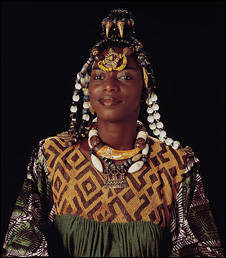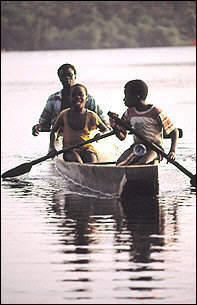 Language and People Language and People |
 LANGUAGE LANGUAGE |
The official language is French. Djula, Baoulé and Bété are widely spoken.
 POPULATION POPULATION |
THE AKAN
A majority ethnic group in the country (41.8%), the Akan are composed of the Baoulé, Agni, Abron and Lagoon peoples, a term including about fifteen different ethnic groups (Abbey, Aburé, Adjukru, Ebrié etc.). Initialy located in the South, South-East and Central part of the country, the Akan group is characterized by an excessive number of women (51.4% of the total population). Undouted, this over-feminity in this group has an impact on the masculinity ratio at national level (97.1 men for 100women).

The analysis of the masculinity ratio shows that the over-feminity in the Akan group starts from. the age of 15 and reaches its peak between 40 and 44 years. It could be assumed that there exists a male over-mortality, or an emigration of Akan men. In the present state of our knowledge, it is impossible to account for such an important important imbalance between men and women among the working population (5-59 years).
The Akan group constitutes 42.7% of the rural population of Ivorian nationality. A high proportion (65.1%) of the Akan live in the rural areas and this can be accounted for by the natural environment (forest or preforested savannah area), wich they took up as soon as they settled in the territory, but also by the agricultural activity wich most of them are devoted to. Nevertheless they represent 40.2% of the Ivorian urban population. That can be explained by the fact one part of the major towns (Abidjan, Bouaké an Yamoussoukro) is located in the areas initially taken up by the Akan group.
THE KROU

This ethnic group is composed of about
fifteen ethnic groups, the main ones being the Bete,
the Bakwe, the Dida, the Godie, the Krou and the
Wê with a number of 1.136.291 persons counted
at the 1988 general population and housing census,
the Krou group accounted for 14.6% of the Ivorian
population and 10.5% of the population of the Côte
d'Ivoire. |
The masculinity ratio of the Krou is slightly higher than that of the Akan, or 98 men for 100 women. About 40% of the people in this group live in the urban area, women get the better of men (95 men for 100women). Therefore, one could think that a greater number of men migrate to the towns.
THE NORTHERN MANDE
When they settled in the country, the ethnic group, mainly constituted of Malinke, took up the North-West part of the Côte d'Ivoire. This is the third ethnic group in the country after the Akan and the Voltaic by order of importance . With a population amounting to 1.236.129 persons or 15.9% of the population of Ivorian nationality, the Northern Mande are the only ethnic group whose number of men exceeds that of women, at the national level (101 men for 100 women). Where considering their living area, in the urban area, men are more numerous than women (104 men for 100 women) and this, to the detriment of the rural area (97.2 men for 100 women).
The Northern Mande constitute the most urbanize group. More than half of the population(53%) live in the towns. The Northern Mande account respectively for 23.2% of the urban population of Ivorian natoinality and 15.5% of the population of the Côte d'Ivoire living in the urban areas. The high proportion of Northern Mande in the urban areas might be explained by the important business activity carried out by the Malinke commonly called the Djula.
THE SOUTHERN MANDE
Composed of the Dan, Yacouba, Toura, Gouro ethnic groups this ethnic group, settled the western and central west part of the country. The Southern Mande account for10.7% of the Ivorian population. 72.6% of them live in the rural areas as against 27.4% in the urban areas. The weight of this ethnic group in the Ivorian rural and urban populations is respectively of 12.2% and 8%.
The great number of the Southern Mande in the rural areas could, on the one hand, result from. the space occupation (forest area), when they settled in the country and on the other hand, from. economic activity (agricuture) carried out by most of the ethnic groups composing this group.
The ratios of men recorded according to the living areas are like those of the other ethnic groups, namely an excess of men in the urban area (106.8 men for 100 women) and too many women in the rural areas (96.1 men for 100 women).
At the national level, the sex-ratio is of 98.9 men for 100 women. Like in most ethnic groups, the deficit of men starts from. the age of 15 and ends at the age of 49.
THE VOLTAIC
This ethnic group can be found in the Northern and North-Eastern part of the Côte d'Ivoire. The most important ethnic group is constituted by the Senoufo. To them, one can add the Tagouana, the Djimini, the Koulango and the Lobi etc.
The Voltaic group ranks second in the country (after the Akan group) from. the population it includes. A little more than 16% of the Ivorian population descends from. this group, three quarters of them living in the rural areas.
The great number of Voltaic people in rural areas is not fortuitous, for the Senoufo who constitute the great majority of the persons of this group are farmers.
One also notes that among the Voltaic, there is
a deficit of men (97.9 men for 100 women). In the
rural areas, this ratio is 95.8 men for 100 women,
whereas in town, one observes a great number of
men (104.8) in the Voltaic group. |

